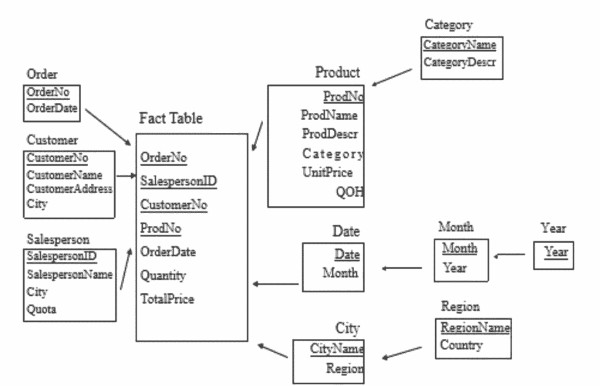Star Schema and Snowflake Schema are two common data modeling techniques used in data warehousing and database design. They have their own advantages and disadvantages, and their suitability depends on the specific requirements of the data warehouse or analytical system.
Star Schema:
-
Structure: In a Star Schema, data is organized into a central fact table surrounded by dimension tables. The fact table contains quantitative data, such as sales or revenue, and is connected to dimension tables through foreign keys.

-
Advantages:
- Simplicity: Star schemas are relatively easy to understand and implement.
- Performance: Queries tend to be fast because joins are typically between the fact table and one or a few dimension tables.
- Aggregation: Aggregating data for reporting and analysis is straightforward.
-
Disadvantages:
- Redundancy: Dimension data may be duplicated in multiple dimension tables, leading to data redundancy.
- Data Integrity: Maintaining data integrity can be challenging because updates or changes in dimension data may require updates in multiple places.
Snowflake Schema:
-
Structure: A Snowflake Schema is an extension of the Star Schema where dimension tables are normalized. This means breaking down dimension tables into sub-dimensions, which are connected through multiple levels of relationships.

-
Advantages:
- Data Integrity: Normalization reduces data redundancy and helps maintain data integrity.
- Storage Efficiency: Snowflake schemas typically require less storage space compared to star schemas.
-
Disadvantages:
- Complexity: Snowflake schemas are more complex to design and understand than star schemas due to the multiple levels of normalization.
- Query Performance: Query performance may suffer because more joins are needed to retrieve data from normalized dimension tables.
- Aggregation Complexity: Aggregating data for reporting can be more complex in a snowflake schema
Comparision
| Aspect |
Star Schema |
Snowflake Schema |
| Structure |
Central fact table surrounded by dimension tables. |
Dimension tables are further normalized into sub-dimensions or sub-levels. |
| Data Redundancy |
Dimension tables often contain some data redundancy (denormalized). |
Dimension tables are more normalized, resulting in less data redundancy. |
| Complexity |
Generally simpler and easier to understand due to fewer tables and relationships. |
More complex due to additional sub-dimensions and relationships, potentially more tables. |
| Storage Space |
May require more storage space due to data redundancy. |
Requires less storage space compared to star schema due to normalization. |
| Query Performance |
Often offers better query performance, as denormalized tables reduce the need for joins. |
Query performance may be slightly impacted due to the need for more joins. |